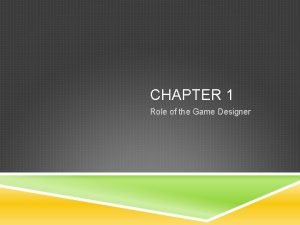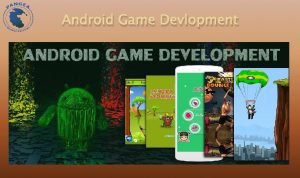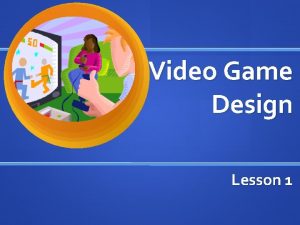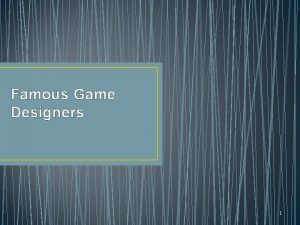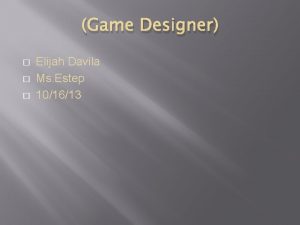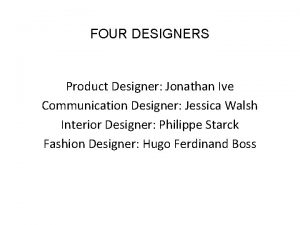CHAPTER 1 Role of the Game Designer AN

















- Slides: 17

CHAPTER 1 Role of the Game Designer

AN ADVOCATE FOR THE PLAYER The role of the game designer is, first and foremost to be an advocate for the player As a game designer, a large part of your role is to keep your concentration focused on the player experience and not allow yourself to be distracted by the concerns of production

PLAYTESTERS Play testers are people who play your game and provide feedback on the experience so that you can move forward with a fresh perspective. By watching other people play the game, you can learn an great deal Complete Exercise 1. 1: Become a Tester

PASSIONS AND SKILLS Communication Teamwork Process Inspiration Becoming a Better Player Creativity

COMMUNICATION The most important skill that you can develop as a game designer is the ability to communicate clearly and effectively with all the other people who will be working on your game

TEAMWORK From the hardcore computer scientists who might be designing graphic displays, to the talented illustrators and animators who bring the characters to life, to the money-minded executives and business managers who deliver the game to its players, the range of personalities that you will need to collaborate with is intense.

PROCESS Games are fragile systems, and each element is inextricably linked to the others so a change in one variable can send disruptive ripples throughout. This is particularly catastrophic in the final phases of development, where you run out of time, mistakes are left unfixed and portions of the game are amputated in the hopes of saving what's left. It’s gruesome, but it might help you understand why some games are D. O. A. Complete Exercise 1. 2: D. O. A

INSPIRATION A game designer often looks at the world differently from most people. When a game designer looks at the world, he often sees things in terms of challenges, structures and play. Games are all around us Complete Exercise 1. 3: Your Life as a Game

BECOMING A BETTER PLAYER By “better” we don’t just mean more skilled or someone who wins all the time. What we mean is using yourself and your experience with games to develop an unerring sense for good gameplay. If you want to be a good game player you need to learn to play with the same conscious sensitivity to your own experience and critical analysis of the underlying system.

A PLAYCENTRIC DESIGN PROCESS Setting Player Experience Goals that the game designer sets for the type of experience that players will have during the game These are not features but rather descriptions of the interesting and unique situations in which you hope the players will find themselves Example: Players will have the freedom to pursue the goals of the game in any order they choose

PROTOTYPING AND PLAYTESTING Immediately after brainstorming ideas designers should construct a playable version of their idea A physical prototype can use paper and pen, index cards or even be acted out. It is meant to be played by the designer and her friends

ITERATION Step 1: Brainstorming Step 2: Physical Prototype Step 3: Presentation (Optional) Step 4: Software Prototypes Step 5: Design Documentation Step 6: Production Step 7: Quality Assurance

DESIGNING FOR INNOVATION Designing games with unique play mechanics – thinking beyond existing genres of play Appealing to new players Solving difficult problems in game design Ask difficult questions about what games are, what they can be and what their impact is on us individually and culturally.

PETER MOLYNEUX – THIS SLIDE AND THE NEXT THREE ON YOUR OWN USING THE BOOK PAGES 22 -24 Managing Director, Lionhead Studios 20 year veteran of the game industry Game designer on many influential titles: ________________________ ________________________

HAVE YOU PLAYED ANY OF PETER’S GAMES? WHAT DO YOU THINK?

WHAT WERE WARREN SPECTOR’S GAME INFLUENCES? Ultima IV Super Mario 64 Star Raiders Ico Suikoden

WHAT ARE YOUR GAME INFLUENCES?
 Game designer role
Game designer role Fiche metier concepteur de jeux video
Fiche metier concepteur de jeux video Worker role azure
Worker role azure Krappmann schaubild
Krappmann schaubild Statuses and their related roles determine the structure
Statuses and their related roles determine the structure Role models game
Role models game Hát kết hợp bộ gõ cơ thể
Hát kết hợp bộ gõ cơ thể Lp html
Lp html Bổ thể
Bổ thể Tỉ lệ cơ thể trẻ em
Tỉ lệ cơ thể trẻ em Gấu đi như thế nào
Gấu đi như thế nào Tư thế worm breton
Tư thế worm breton Chúa sống lại
Chúa sống lại Môn thể thao bắt đầu bằng từ đua
Môn thể thao bắt đầu bằng từ đua Thế nào là hệ số cao nhất
Thế nào là hệ số cao nhất Các châu lục và đại dương trên thế giới
Các châu lục và đại dương trên thế giới Công thức tiính động năng
Công thức tiính động năng Trời xanh đây là của chúng ta thể thơ
Trời xanh đây là của chúng ta thể thơ
